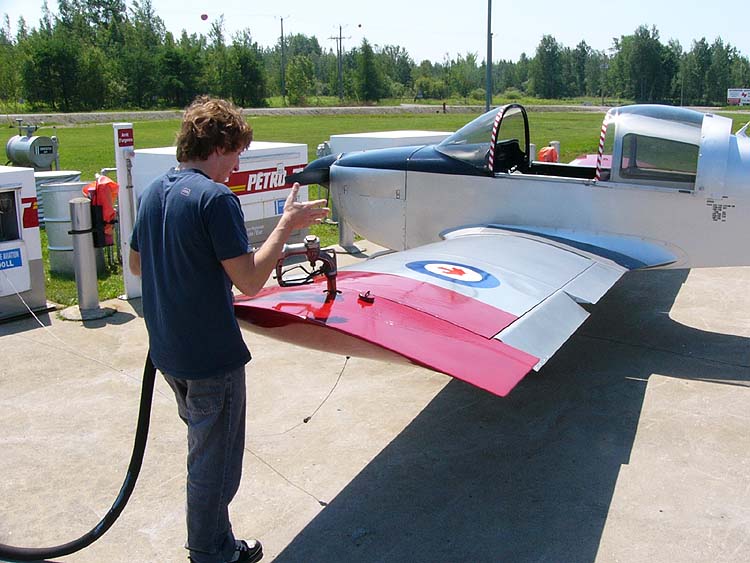|
Kawanishi Maru Ka10
The Kawanishi Maru Ka10 was a World War II Japanese pulsejet engine based on the German Argus As 014 (as used in the V-1 flying bomb). The Ka10’s only intended application was the Kawanishi Baika. Design and development Japanese scientists received drawings of the Argus 014 PulseJet from the I-8 submarine’s technology exchange mission to German-occupied France in 1943. A Japanese version of the Argus 014, the Maru Ka10, was designed by Professors Ichiro Tami and Taichiro Ogawa of the Aeronautical Institute of Tokyo Imperial University during 1944. Initial tests of the Ka10 were performed using benzole as a fuel however the engine was designed to run on various fuels including heavy kerosene and pine oil. The use of substitute fuels avoided the need to use aviation gasoline which was in short supply by 1944. The Ka10 was far less complex than contemporary turbojet or piston engines and the intention was for the pulsejets to be built by unskilled or semi-skilled laborers ... [...More Info...] [...Related Items...] OR: [Wikipedia] [Google] [Baidu] |
Pulsejet
file:Pulse Jet Engine.PNG, 300px, Diagram of a valved pulsejet. 1 - Air enters through valve and is mixed with fuel. 2 - The mixture is ignited, expands, closes the valve and exits through the tailpipe, creating thrust.3 - Low pressure in the engine opens the valve and draws in air. A pulsejet engine (or pulse jet) is a type of jet engine in which combustion occurs in Pulse (physics), pulses. A pulsejet engine can be made with few or no moving parts, and is capable of running statically (that is, it does not need to have air forced into its inlet, typically by forward motion). The best known example is the Argus As 109-014 used to propel Nazi Germany's V-1 flying bomb. Pulsejet engines are a lightweight form of jet propulsion, but usually have a poor compression ratio, and hence give a low specific impulse. The two main types of pulsejet engines use resonant combustion and harness the combustion products to form a pulsating exhaust jet that intermittently produces thrust. T ... [...More Info...] [...Related Items...] OR: [Wikipedia] [Google] [Baidu] |
Pine Oil
Pine oil is an essential oil obtained from a variety of species of pine, particularly ''Pinus sylvestris''. Typically, parts of the trees that are not used for lumber stumps, etc. are ground and subjected to steam distillation. As of 1995, synthetic pine oil was the "biggest single turpentine derivative." Synthetic pine oils accounted for 90% of sales as of 2000. Composition Pine oil is a higher boiling fraction from turpentine. Both synthetic and natural pine oil consists mainly of őĪ-terpineol, a C10 alcohol (b.p. 214‚Äď217 ¬įC).''Merck Index'', 11th Edition, 7416. p. 1182 Other components include dipentene and pinene. The detailed composition of natural pine oil depends on many factors, such as the species of the host plant. Synthetic pine oil is obtained by treating pinene with water in the presence of a catalytic amount of sulfuric acid. This treatment results in hydration of the alkene and rearrangement of the pinene skeleton, yielding terpineols. Uses Industrially, ... [...More Info...] [...Related Items...] OR: [Wikipedia] [Google] [Baidu] |
Turpentine
Turpentine (which is also called spirit of turpentine, oil of turpentine, terebenthine, terebenthene, terebinthine and, colloquially, turps) is a fluid obtainable by the distillation of resin harvested from living trees, mainly pines. Principally used as a specialized solvent, it is also a source of material for Organic synthesis, organic syntheses. Turpentine is composed of terpenes, primarily the monoterpenes alpha-Pinene, alpha- and beta-Pinene, beta-pinene, with lesser amounts of carene, camphene, limonene, and terpinolene.Kent, James A. ''Riegel's Handbook of Industrial Chemistry'' (Eighth Edition) Van Nostrand Reinhold Company (1983) p.569 Nowadays, turpentine is rarely the product of distillation of pine resin, but is a byproduct of pulping. Pulping is achieved by two processes, the Kraft process and the sulfite process. The turpentines obtained from these two processes differ in their chemical compositions. The sulfite process gives a product that is rich in cymene, w ... [...More Info...] [...Related Items...] OR: [Wikipedia] [Google] [Baidu] |
Benzole
In the United Kingdom, benzole or benzol is a coal-tar product consisting mainly of benzene and toluene. It was originally used as a "motor spirit", as were petroleum spirits. Benzole was also blended with petrol and sold as a motor fuel under trade names including "National Benzole Mixture" and "Regent Benzole Mixture". Confusingly, in certain languages, such as German, Hungarian, Ukrainian and Russian, the word ''benzol'' (or ''benzole'') means "benzene", and in some of these languages, words pronounced like "benzene" (e.g., the German word or the Romanian word benzinńÉ) can mean "petrol" or "gasoline".Collins German Concise Dictionary, 1991, {{ISBN, 0-00-433454-X See also * Antiknock agent An antiknock agent (also: knock inhibitor) is a gasoline additive used to reduce engine knocking and increase the fuel's octane rating by raising the temperature and pressure at which auto-ignition occurs. The mixture known as gasoline or petrol, ... References External links The ... [...More Info...] [...Related Items...] OR: [Wikipedia] [Google] [Baidu] |
WikiProject Aircraft
A WikiProject, or Wikiproject, is an affinity group for contributors with shared goals within the Wikimedia movement. WikiProjects are prevalent within the largest wiki, Wikipedia, and exist to varying degrees within Wikimedia project, sibling projects such as Wiktionary, Wikiquote, Wikidata, and Wikisource. They also exist in different languages, and translation of articles is a form of their collaboration. During the COVID-19 pandemic, CBS News noted the role of Wikipedia's WikiProject Medicine in maintaining the accuracy of articles related to the disease. Another WikiProject that has drawn attention is WikiProject Women Scientists, which was profiled by ''Smithsonian Magazine, Smithsonian'' for its efforts to improve coverage of women scientists which the profile noted had "helped increase the number of female scientists on Wikipedia from around 1,600 to over 5,000". On Wikipedia Some Wikipedia WikiProjects are substantial enough to engage in cooperative activities with outsi ... [...More Info...] [...Related Items...] OR: [Wikipedia] [Google] [Baidu] |
Fieseler Fi 103R Reichenberg
The Fieseler Fi 103R, code-named ''Reichenberg'', was a German manned version of the V-1 flying bomb (more correctly known as the ''Fieseler Fi 103''). It was developed towards the end of the Second World War and was intended to be used as a human-guided bomb in suicidal attacks against the advancing Allies. The Fi 103R started development in 1944 at a time when Germany was anticipating a major naval landing by the Allies in western Europe. It was believed that a disposable aircraft armed with of explosives would potentially inflict heavy damage on important targets such as enemy shipping. However, these attacks would have very likely involved the death of the pilot, who was expected to exit the aircraft and parachute away mere moments before the aircraft's impact. These pilots were reportedly to be volunteers and aware of the risk to their own lives. The " Leonidas Squadron", V. ''Gruppe'' of the Luftwaffe's Kampfgeschwader 200, was established in early 1944 to conduct these ... [...More Info...] [...Related Items...] OR: [Wikipedia] [Google] [Baidu] |
Reciprocating Engine
A reciprocating engine, more often known as a piston engine, is a heat engine that uses one or more reciprocating pistons to convert high temperature and high pressure into a rotating motion. This article describes the common features of all types. The main types are: the internal combustion engine, used extensively in motor vehicles; the steam engine, the mainstay of the Industrial Revolution; and the Stirling engine for niche applications. Internal combustion engines are further classified in two ways: either a spark-ignition (SI) engine, where the spark plug initiates the combustion; or a compression-ignition (CI) engine, where the air within the cylinder is compressed, thus heating it, so that the heated air ignites fuel that is injected then or earlier.''Thermodynamics: An Engineering Approach'' by Yunus A. Cengal and Michael A. Boles Common features in all types There may be one or more pistons. Each piston is inside a cylinder, into which a gas is introduced, e ... [...More Info...] [...Related Items...] OR: [Wikipedia] [Google] [Baidu] |
Turbojet
The turbojet is an airbreathing jet engine which is typically used in aircraft. It consists of a gas turbine with a propelling nozzle. The gas turbine has an air inlet which includes inlet guide vanes, a compressor, a combustion chamber, and a turbine (that drives the compressor). The compressed air from the compressor is heated by burning fuel in the combustion chamber and then allowed to expand through the turbine. The turbine exhaust is then expanded in the propelling nozzle where it is accelerated to high speed to provide thrust. Two engineers, Frank Whittle in the United Kingdom and Hans von Ohain in Germany, developed the concept independently into practical engines during the late 1930s. Turbojets have poor efficiency at low vehicle speeds, which limits their usefulness in vehicles other than aircraft. Turbojet engines have been used in isolated cases to power vehicles other than aircraft, typically for attempts on land speed records. Where vehicles are "turbine-powere ... [...More Info...] [...Related Items...] OR: [Wikipedia] [Google] [Baidu] |
Avgas
Avgas (aviation gasoline, also known as aviation spirit in the United Kingdom, UK) is an aviation fuel used in aircraft with spark-ignited internal combustion engines. ''Avgas'' is distinguished from conventional gasoline (petrol) used in motor vehicles, which is termed ''mogas'' (motor gasoline) in an aviation context. Unlike motor gasoline, which has been formulated without lead since the 1970s to allow the use of catalytic converters for pollution reduction, the most commonly used grades of avgas still contain tetraethyllead, tetraethyl lead, a toxic lead-containing additive used to aid in lubrication of the engine, increase octane rating, and prevent engine knocking (spark-knock). There are ongoing efforts to reduce or eliminate the use of lead in aviation gasoline. Kerosene-based jet fuel is formulated to suit the requirements of gas turbine, turbine engines which have no octane requirement and operate over a much wider flight envelope than piston engines. Kerosene is also ... [...More Info...] [...Related Items...] OR: [Wikipedia] [Google] [Baidu] |
Kerosene
Kerosene, or paraffin, is a combustibility, combustible hydrocarbon liquid which is derived from petroleum. It is widely used as a fuel in Aviation fuel, aviation as well as households. Its name derives from the Greek (''kńďr√≥s'') meaning "wax"; it was registered as a trademark by Nova Scotian, Nova Scotia geologist and inventor Abraham Pineo Gesner, Abraham Gesner in 1854 before evolving into a generic trademark. It is sometimes spelled kerosine in scientific and industrial usage. Kerosene is widely used to power jet engines of aircraft (jet fuel), as well as some rocket engines in a highly refined form called RP-1. It is also commonly used as a cooking and lighting fuel, and for fire toys such as Poi (performance art)#Fire poi, poi. In parts of Asia, kerosene is sometimes used as fuel for small outboard motors or even motorcycles. World total kerosene consumption for all purposes is equivalent to about 5,500,000 barrels per day as of July 2023. The term "kerosene" is comm ... [...More Info...] [...Related Items...] OR: [Wikipedia] [Google] [Baidu] |
Kawanishi Aircraft Company
The was a Japanese aircraft manufacturer active during World War II. History The company was founded as Kawanishi Engineering Works in 1920 in HyŇćgo Prefecture as an outgrowth of the Kawanishi conglomerate, which had been funding the Nakajima Aircraft Company. Kawanishi built its first aircraft, the Kawanishi K-1 Mail-carrying Aircraft in 1921, and set up an airline, ''Nippon Koku K.K.'' (Japan Aviation Co. Ltd) in 1923, designing and building several aircraft for the airline's use. It was forced by the Japanese government to shut down ''Nippon Koku'' in 1929, however, with its routes being transferred to the government-owned ''Nippon Koku Yuso K.K.'' (Japan Air Transport Co. Ltd.) Kawanishi then split off the former Kawanishi Engineering Works, forming ''Kawanishi Kokuki KK'' in 1928, taking all of the Kawanishi Engineering Works' assets.Mikesh and Abe 1990, pp. 124‚Äď125. While Kawanishi was best known for its seaplanes, such as the Kawanishi H6K and H8K flying boats, its ... [...More Info...] [...Related Items...] OR: [Wikipedia] [Google] [Baidu] |
Benzole
In the United Kingdom, benzole or benzol is a coal-tar product consisting mainly of benzene and toluene. It was originally used as a "motor spirit", as were petroleum spirits. Benzole was also blended with petrol and sold as a motor fuel under trade names including "National Benzole Mixture" and "Regent Benzole Mixture". Confusingly, in certain languages, such as German, Hungarian, Ukrainian and Russian, the word ''benzol'' (or ''benzole'') means "benzene", and in some of these languages, words pronounced like "benzene" (e.g., the German word or the Romanian word benzinńÉ) can mean "petrol" or "gasoline".Collins German Concise Dictionary, 1991, {{ISBN, 0-00-433454-X See also * Antiknock agent An antiknock agent (also: knock inhibitor) is a gasoline additive used to reduce engine knocking and increase the fuel's octane rating by raising the temperature and pressure at which auto-ignition occurs. The mixture known as gasoline or petrol, ... References External links The ... [...More Info...] [...Related Items...] OR: [Wikipedia] [Google] [Baidu] |






